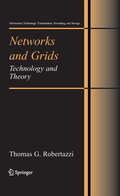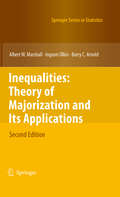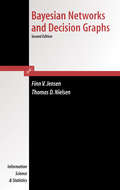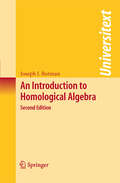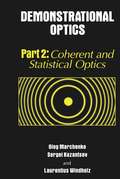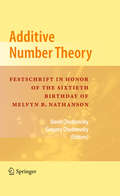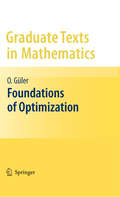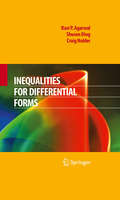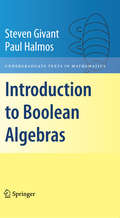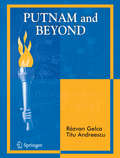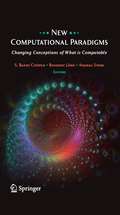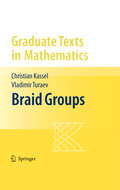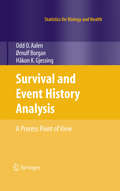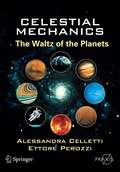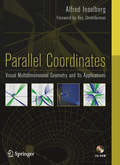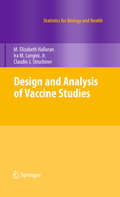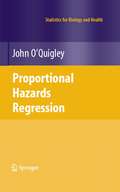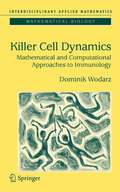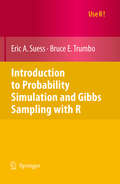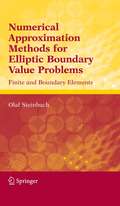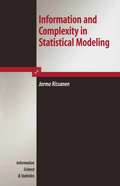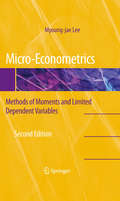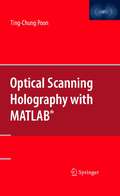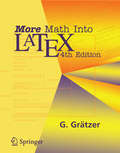- Table View
- List View
Networks and Grids: Technology and Theory (Information Technology: Transmission, Processing and Storage)
by Thomas G. RobertazziThis useful volume adopts a balanced approach between technology and mathematical modeling in computer networks, covering such topics as switching elements and fabrics, Ethernet, and ALOHA design. The discussion includes a variety of queueing models, routing, protocol verification and error codes and divisible load theory, a new modeling technique with applications to grids and parallel and distributed processing. Examples at the end of each chapter provide ample material for practice. This book can serve as an text for an undergraduate or graduate course on computer networks or performance evaluation in electrical and computer engineering or computer science.
Inequalities: Theory of Majorization and Its Applications (Springer Series in Statistics)
by Albert W. Marshall Ingram Olkin Barry C. ArnoldThis book’s first edition has been widely cited by researchers in diverse fields. The following are excerpts from reviews. “Inequalities: Theory of Majorization and its Applications” merits strong praise. It is innovative, coherent, well written and, most importantly, a pleasure to read. … This work is a valuable resource!” (Mathematical Reviews). “The authors … present an extremely rich collection of inequalities in a remarkably coherent and unified approach. The book is a major work on inequalities, rich in content and original in organization.” (Siam Review). “The appearance of … Inequalities in 1979 had a great impact on the mathematical sciences. By showing how a single concept unified a staggering amount of material from widely diverse disciplines–probability, geometry, statistics, operations research, etc.–this work was a revelation to those of us who had been trying to make sense of his own corner of this material.” (Linear Algebra and its Applications). This greatly expanded new edition includes recent research on stochastic, multivariate and group majorization, Lorenz order, and applications in physics and chemistry, in economics and political science, in matrix inequalities, and in probability and statistics. The reference list has almost doubled.
Bayesian Networks and Decision Graphs (Information Science and Statistics)
by Thomas Dyhre Nielsen FINN VERNER JENSENThis is a brand new edition of an essential work on Bayesian networks and decision graphs. It is an introduction to probabilistic graphical models including Bayesian networks and influence diagrams. The reader is guided through the two types of frameworks with examples and exercises, which also give instruction on how to build these models. Structured in two parts, the first section focuses on probabilistic graphical models, while the second part deals with decision graphs, and in addition to the frameworks described in the previous edition, it also introduces Markov decision process and partially ordered decision problems.
An Introduction to Homological Algebra (Universitext)
by Joseph J. RotmanGraduate mathematics students will find this book an easy-to-follow, step-by-step guide to the subject. Rotman’s book gives a treatment of homological algebra which approaches the subject in terms of its origins in algebraic topology. In this new edition the book has been updated and revised throughout and new material on sheaves and cup products has been added. The author has also included material about homotopical algebra, alias K-theory. Learning homological algebra is a two-stage affair. First, one must learn the language of Ext and Tor. Second, one must be able to compute these things with spectral sequences. Here is a work that combines the two.
Demonstrational Optics: Part 2, Coherent and Statistical Optics
by Oleg Marchenko Sergi Kazantsev Laurentius WindholzThis book presents a new didactical approach to the study of optics. It emphasizes the importance of elaborate new experimental demonstrations containing pictorial illustrations, computer simulations and models of optical phenomena in order to ensure a deeper understanding of wave and geometric optics. It includes problems focused on the pragmatic needs of students, secondary school teachers, university professors and optical engineers. A substantial part of this volume is devoted to thermal radiation and its properties, especially with partial coherence. The book contains detailed descriptions of demonstrational experiments.
Additive Number Theory: Festschrift In Honor of the Sixtieth Birthday of Melvyn B. Nathanson
by David Chudnovsky Gregory ChudnovskyThis impressive volume is dedicated to Mel Nathanson, a leading authoritative expert for several decades in the area of combinatorial and additive number theory. For several decades, Mel Nathanson's seminal ideas and results in combinatorial and additive number theory have influenced graduate students and researchers alike. The invited survey articles in this volume reflect the work of distinguished mathematicians in number theory, and represent a wide range of important topics in current research.
Inequalities for Differential Forms
by Ravi P. Agarwal Shusen Ding Craig NolderThis monograph is the first one to systematically present a series of local and global estimates and inequalities for differential forms, in particular the ones that satisfy the A-harmonic equations. The presentation focuses on the Hardy-Littlewood, Poincare, Cacciooli, imbedded and reverse Holder inequalities. Integral estimates for operators, such as homotopy operator, the Laplace-Beltrami operator, and the gradient operator are discussed next. Additionally, some related topics such as BMO inequalities, Lipschitz classes, Orlicz spaces and inequalities in Carnot groups are discussed in the concluding chapter. An abundance of bibliographical references and historical material supplement the text throughout. This rigorous presentation requires a familiarity with topics such as differential forms, topology and Sobolev space theory. It will serve as an invaluable reference for researchers, instructors and graduate students in analysis and partial differential equations and could be used as additional material for specific courses in these fields.
Putnam and Beyond
by Razvan Gelca Titu AndreescuPutnam and Beyond takes the reader on a journey through the world of college mathematics, focusing on some of the most important concepts and results in the theories of polynomials, linear algebra, real analysis in one and several variables, differential equations, coordinate geometry, trigonometry, elementary number theory, combinatorics, and probability. Using the W.L. Putnam Mathematical Competition for undergraduates as an inspiring symbol to build an appropriate math background for graduate studies in pure or applied mathematics, the reader is eased into transitioning from problem-solving at the high school level to the university and beyond, that is, to mathematical research.
Life Distributions: Structure of Nonparametric, Semiparametric, and Parametric Families (Springer Series in Statistics)
by Albert W. Marshall Ingram OlkinThis book is devoted to the study of univariate distributions appropriate for the analyses of data known to be nonnegative. The book includes much material from reliability theory in engineering and survival analysis in medicine.
New Computational Paradigms: Changing Conceptions of What is Computable
by S. B. Cooper Benedikt Löwe Andrea SorbiThis superb exposition of a complex subject examines new developments in the theory and practice of computation from a mathematical perspective, with topics ranging from classical computability to complexity, from biocomputing to quantum computing. This book is suitable for researchers and graduate students in mathematics, philosophy, and computer science with a special interest in logic and foundational issues. Most useful to graduate students are the survey papers on computable analysis and biological computing. Logicians and theoretical physicists will also benefit from this book.
Braid Groups (Graduate Texts in Mathematics #247)
by Christian Kassel Vladimir TuraevIn this well-written presentation, motivated by numerous examples and problems, the authors introduce the basic theory of braid groups, highlighting several definitions that show their equivalence; this is followed by a treatment of the relationship between braids, knots and links. Important results then treat the linearity and orderability of the subject. Relevant additional material is included in five large appendices. Braid Groups will serve graduate students and a number of mathematicians coming from diverse disciplines.
Survival and Event History Analysis: A Process Point of View (Statistics for Biology and Health)
by Odd Aalen Ornulf Borgan Hakon GjessingThe aim of this book is to bridge the gap between standard textbook models and a range of models where the dynamic structure of the data manifests itself fully. The common denominator of such models is stochastic processes. The authors show how counting processes, martingales, and stochastic integrals fit very nicely with censored data. Beginning with standard analyses such as Kaplan-Meier plots and Cox regression, the presentation progresses to the additive hazard model and recurrent event data. Stochastic processes are also used as natural models for individual frailty; they allow sensible interpretations of a number of surprising artifacts seen in population data. The stochastic process framework is naturally connected to causality. The authors show how dynamic path analyses can incorporate many modern causality ideas in a framework that takes the time aspect seriously. To make the material accessible to the reader, a large number of practical examples, mainly from medicine, are developed in detail. Stochastic processes are introduced in an intuitive and non-technical manner. The book is aimed at investigators who use event history methods and want a better understanding of the statistical concepts. It is suitable as a textbook for graduate courses in statistics and biostatistics.
Celestial Mechanics: The Waltz of the Planets (Springer Praxis Books)
by Alessandra Celletti Ettore PerozziThe aim of this book is to demonstrate to a wider audience, as well as to a more skilled audience, the many fascinating aspects of modern celestial mechanics. It sets out to do this without the use of mathematics. After giving the reader the technical tools needed for a basic understanding of the underlying physical phenomena (using only elementary mathematics), facts and figures are provided on historical events, modern discoveries and future applications. Contents are divided into major topics where the three "souls" of modern celestial mechanics (dynamical systems, Solar System and stellar systems, spaceflight dynamics) play a major role.
Parallel Coordinates: Visual Multidimensional Geometry and Its Applications
by Alfred InselbergThis is one book that can genuinely be said to be straight from the horse’s mouth. Written by the originator of the technique, it examines parallel coordinates as the leading methodology for multidimensional visualization. Starting from geometric foundations, this is the first systematic and rigorous exposition of the methodology's mathematical and algorithmic components. It covers, among many others, the visualization of multidimensional lines, minimum distances, planes, hyperplanes, and clusters of "near" planes. The last chapter explains in a non-technical way the methodology's application to visual and automatic data mining. The principles of the latter, along with guidelines, strategies and algorithms are illustrated in detail on real high-dimensional datasets.
Design and Analysis of Vaccine Studies: (pdf) (Statistics for Biology and Health)
by M. Elizabeth Halloran Claudio J. Struchiner Ira M. Longini Jr.Proportional Hazards Regression (Statistics for Biology and Health)
by John O'QuigleyThe place in survival analysis now occupied by proportional hazards models and their generalizations is so large that it is no longer conceivable to offer a course on the subject without devoting at least half of the content to this topic alone. This book focuses on the theory and applications of a very broad class of models – proportional hazards and non-proportional hazards models, the former being viewed as a special case of the latter – which underlie modern survival analysis. Researchers and students alike will find that this text differs from most recent works in that it is mostly concerned with methodological issues rather than the analysis itself.
Killer Cell Dynamics: Mathematical and Computational Approaches to Immunology (Interdisciplinary Applied Mathematics #32)
by Dominik WodarzThis book reviews how mathematical and computational approaches can be useful to help us understand how killer T-cell responses work to fight viral infections. It also demonstrates, in a writing style that exemplifies the point, that such mathematical and computational approaches are most valuable when coupled with experimental work through interdisciplinary collaborations. Designed to be useful to immunoligists and viroligists without extensive computational background, the book covers a broad variety of topics, including both basic immunological questions and the application of these insights to the understanding and treatment of pathogenic human diseases.
Introduction to Probability Simulation and Gibbs Sampling with R (Use R!)
by Eric A. Suess Bruce E. TrumboThe first seven chapters use R for probability simulation and computation, including random number generation, numerical and Monte Carlo integration, and finding limiting distributions of Markov Chains with both discrete and continuous states. Applications include coverage probabilities of binomial confidence intervals, estimation of disease prevalence from screening tests, parallel redundancy for improved reliability of systems, and various kinds of genetic modeling. These initial chapters can be used for a non-Bayesian course in the simulation of applied probability models and Markov Chains. Chapters 8 through 10 give a brief introduction to Bayesian estimation and illustrate the use of Gibbs samplers to find posterior distributions and interval estimates, including some examples in which traditional methods do not give satisfactory results. WinBUGS software is introduced with a detailed explanation of its interface and examples of its use for Gibbs sampling for Bayesian estimation. No previous experience using R is required. An appendix introduces R, and complete R code is included for almost all computational examples and problems (along with comments and explanations). Noteworthy features of the book are its intuitive approach, presenting ideas with examples from biostatistics, reliability, and other fields; its large number of figures; and its extraordinarily large number of problems (about a third of the pages), ranging from simple drill to presentation of additional topics. Hints and answers are provided for many of the problems. These features make the book ideal for students of statistics at the senior undergraduate and at the beginning graduate levels.
Numerical Approximation Methods for Elliptic Boundary Value Problems: Finite and Boundary Elements
by Olaf SteinbachThis book presents a unified theory of the Finite Element Method and the Boundary Element Method for a numerical solution of second order elliptic boundary value problems. This includes the solvability, stability, and error analysis as well as efficient methods to solve the resulting linear systems. Applications are the potential equation, the system of linear elastostatics and the Stokes system. While there are textbooks on the finite element method, this is one of the first books on Theory of Boundary Element Methods. It is suitable for self study and exercises are included.
Information and Complexity in Statistical Modeling (Information Science and Statistics)
by Jorma RissanenNo statistical model is "true" or "false," "right" or "wrong"; the models just have varying performance, which can be assessed. The main theme in this book is to teach modeling based on the principle that the objective is to extract the information from data that can be learned with suggested classes of probability models. The intuitive and fundamental concepts of complexity, learnable information, and noise are formalized, which provides a firm information theoretic foundation for statistical modeling. Although the prerequisites include only basic probability calculus and statistics, a moderate level of mathematical proficiency would be beneficial.
Micro-Econometrics: Methods of Moments and Limited Dependent Variables
by Myoung-jae LeeUp-to-date coverage of most micro-econometric topics; first half parametric, second half semi- (non-) parametric Many empirical examples and tips in applying econometric theories to data Essential ideas and steps shown for most estimators and tests; well-suited for both applied and theoretical readers
Optical Scanning Holography with MATLAB®
by Ting-Chung PoonOptical Scanning Holography is an exciting new field with many potential novel applications. This book contains tutorials, research materials, as well as new ideas and insights that will be useful for those working in the field of optics and holography. The book has been written by one of the leading researchers in the field. It covers the basic principles of the topic which will make the book relevant for years to come.
More Math Into LaTeX
by George GrätzerThis is the fourth edition of the standard introductory text and complete reference for scientists in all disciplines, as well as engineers. This fully revised version includes important updates on articles and books as well as information on a crucial new topic: how to create transparencies and computer projections, both for classrooms and professional meetings. The text maintains its user-friendly, example-based, visual approach, gently easing readers into the secrets of Latex with The Short Course. Then it introduces basic ideas through sample articles and documents. It includes a visual guide and detailed exposition of multiline math formulas, and even provides instructions on preparing books for publishers.
